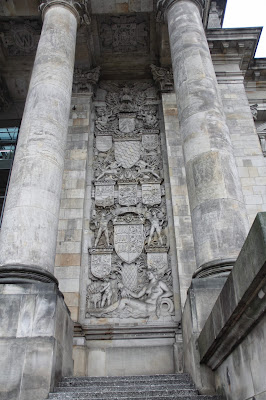"Of course, you'll have to look at The Reichstag", my friend from Berlin e-mailed me back in the summer when we were planning our trip there. As one of the 'must see' things to do in the city we decided to go there not expecting much, but aware of its active present and turbulent past. The guide books all stress the need to book to get in, and to get there in plenty of time for your allotted slot in the schedule. They are right to as well, in addition to that, the guide books also should mention that bringing the paperwork from your internet booking and photo ID is also necessary. We had left our passports in the safe at the hotel, but thankfully had our EU photo-driving licenses on us, which they accepted despite the fact that one of them has expired!
The old building retains its historic exterior, largely intact or reconstructed after the ravages of war. The four corner towers are meant to symbolise the four main nations who came together in formal union in 1871. The interior however, has been completely rebuilt into an incredibly impressive parliament for the the re-Unified Germany.
While the great chamber of the Bundestag dominates the inside of the building, it the great glass dome which has been added to the roof which catches the attention. Early photos of the building show it with a classical dome, which is entirely absent in Cold-War era pictures, now Norman Foster is the architect responsible for re-crowning the building.
The most extraordinary feature of the dome is a great inverted cone made up of hundreds of mirrors, which appears to hang in the dome without support. Rather than just being a weird feature, it serves the purpose of directing light and heat from the glass dome, down into the chamber below.
Visitors can walk their way up a long curving ramp which circles like a helter-skelter, up to a viewing platform at the dome's summit.
While the ramp provides views across the city, and down into the chamber below; it is actually the dome which holds the attention - its is incredible.
At the foot of the dome there is a huge circular window which looks down into the place from which re-unified Germany has been governed since 1999, when central government re-located here from Bonn. Around this there is a photographic display about the history of the Reichstag (now Bundestag). The information about the foundations of Germany is interesting, but the history becomes alarming in the 1930s, when in the face of economic collapse, and the twin threats of Communism and National Socialism; the Reichstag was set on fire. Historians disagree as to whether the Nazis themselves were responsible for the arson attack and the immense damage it caused, or whether they merely used it for their own ends. Either way, it was under the pretence that this fire was the clarion call for a full communist revolt that they were able to pass the notorious 'Enabling Act', which was the legal basis for the Weimar Republic's transformation into The Third Reich. Waverers were frightened enough of communism, or simply bullied into handing Hitler the power to end German democracy for twelve catastrophic years. Again we were struck by the sensitivity with which contemporary Germany addresses the horrors of its past. In the historical and photographic display, there was mention of Hitler, but only one photograph - and even in that his face was partly obscured as he was turned away from the camera towards a group of athletes. Denial of this era would be wrong; providing a platform for any form of veneration would be unthinkable. They have pitched it perfectly, allowing for neither.
Incredibly, this building once the playground of tyrants, is once again a symbol of democracy. The German Democratic Republic (so-called because it wasn't Democratic!), imploded at the end of 1990s, when it became clear that while Kruschev and Brezhnev would act as military guarantors for their allies regimes in Eastern and Central Europe, the new Soviet Premier, Gorbachev would most certainly not. Once this was established, the threat required to permanently allow the failing state to continue was removed and the process of its unravelling was inevitable. East Germany was effectively invited to join the West German democratic system under a formal re-unification presided over by Helmut Kohl.
This reunification was massively popular at the time - but has not been without its detractors subsequently. There are Western taxpayers who think they are over-burdened to pay for the development of the impoverished East. There are those from the former East, who look nostalgically (Ostalgically, actually) back at the days of equal opportunities, equal incomes and full employment and forget the Stasi; while most disturbingly the last communist ruler of the East, Egon Krenz, described Re-Unification as an "Anschluss". Yet despite these minority voices, and the inevitable hurdles to face, the Re-Unification of two states who for half a century had parallel, but totally different and incompatible systems; has been astonishingly successful. They have also symbolised this process with a quite amazing building.











No comments:
Post a Comment